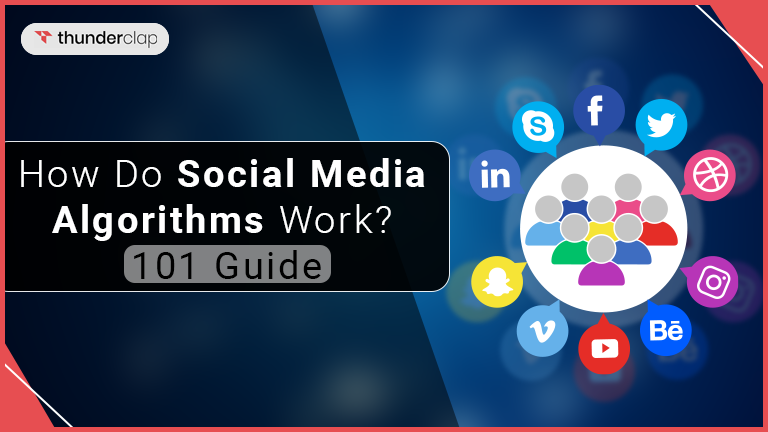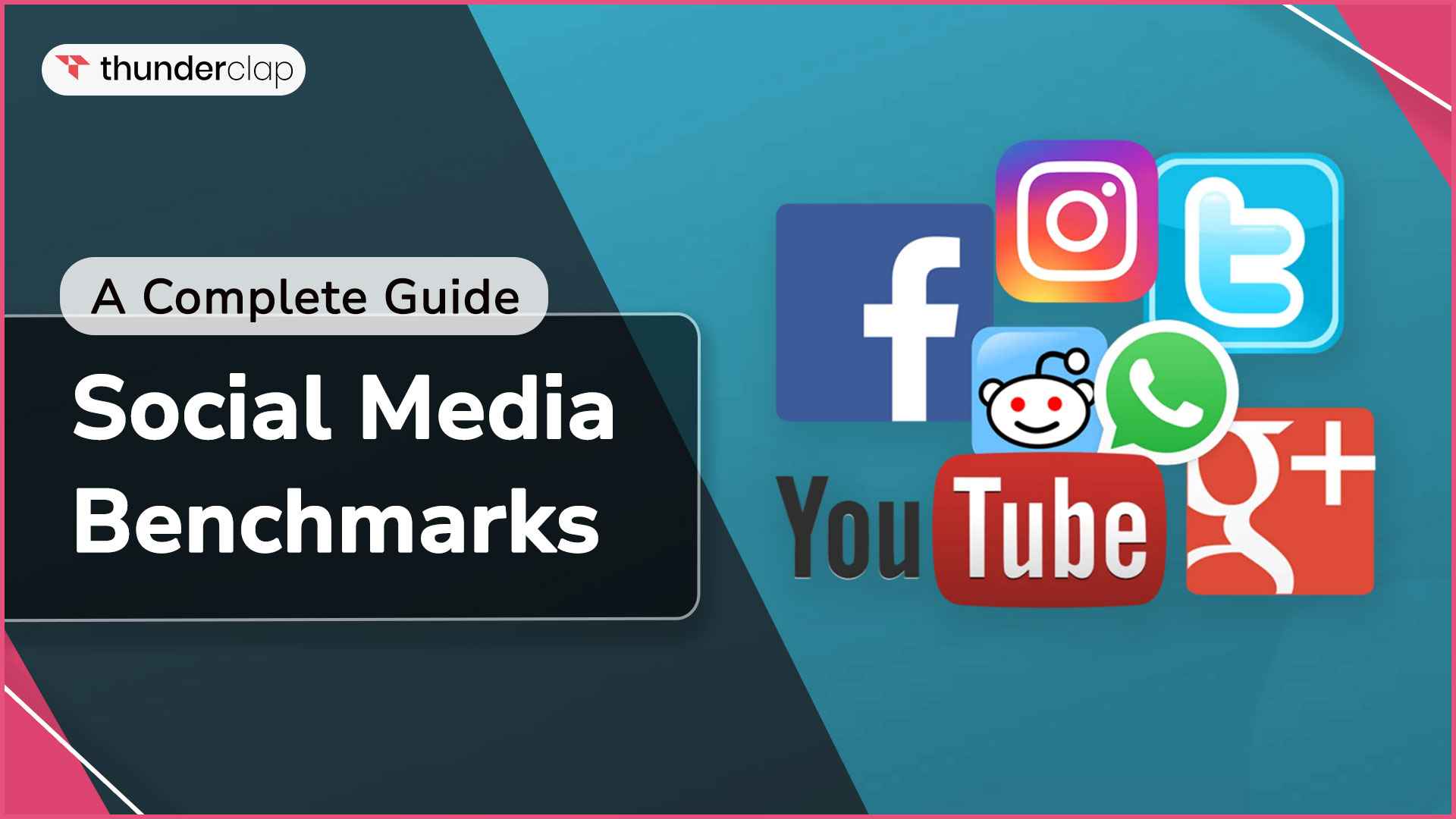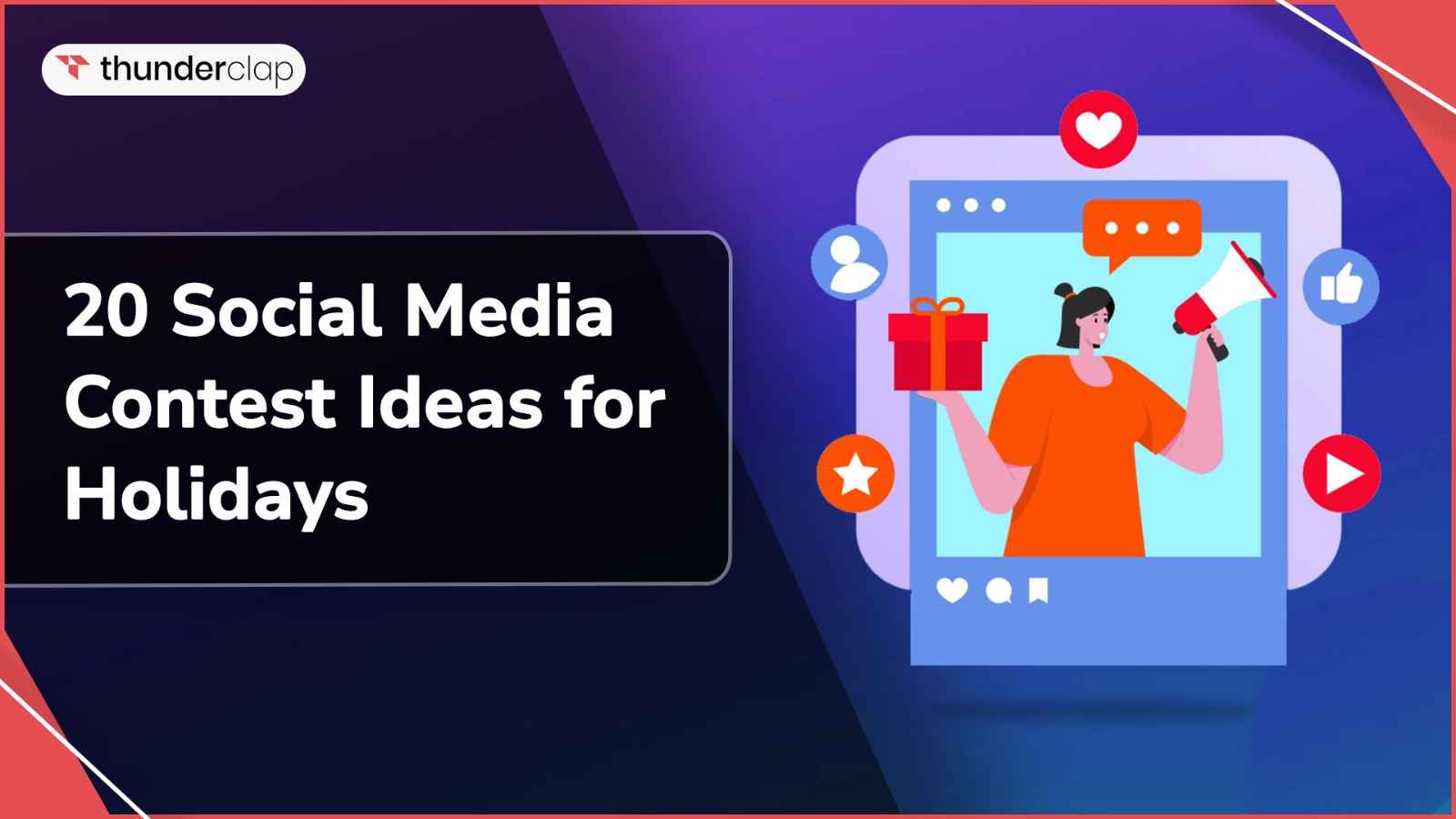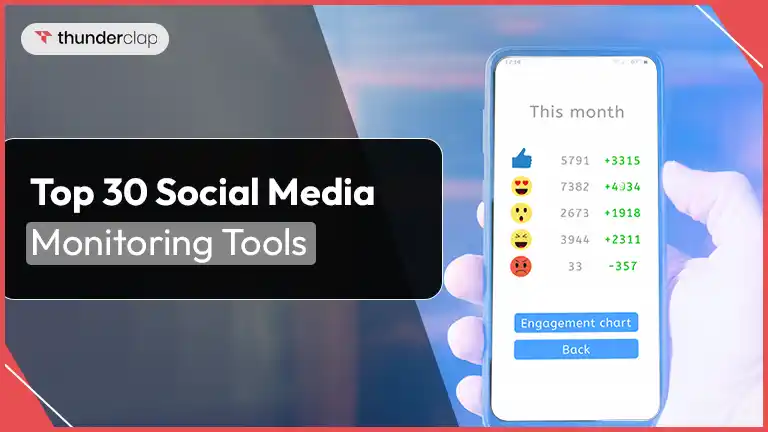
Without question, social media has taken on a crucial role in our daily lives. Over 60% of people use social media platforms. These platforms have a vast user base; thus, it's necessary to establish order and relevancy, which algorithms can accomplish.
The algorithm also determines the rank of your posts on social media feeds and ads. However, knowing every detail that goes into every modification is sometimes tricky. Therefore, it can be challenging for creators to be on top of constantly changing social media algorithms.
But this blog will explain every aspect of social media algorithms and show you how to maximize the reach and interaction of your posts on social media.
The guide will tell you in and out of social media algorithms, their work, and their use. But before getting into the complex subject of how social media algorithms work let's dive into its primary world to understand it better.
What Does Social Media Algorithm Mean?
The core of any social network is its social media algorithms. Social media networks utilize an intricate set of guidelines and formulas called an algorithm to determine which material should appear first in users' feeds.
It considers various crucial algorithmic parameters, including users' historical behavior, content relevance, and post popularity. Social media algorithms also use information about user usage to decide which posts should appear in their feed.
Importance Of Social Media Algorithms
Every social media network has a diverse user base with various interests. In the absence of a filtering system, users are forced to sift through an excessive amount of postings. Here's when and why algorithms are helpful.
Benefits of social media algorithms
The versatility of these algorithms makes everything achievable on social media if used properly. Here are the top benefits of social media algorithms:
- Increases organic reach
Knowledge of social media algorithms helps improve your online visibility on social media. The algorithm gets more adept at identifying users who share your interests the more people discover your work.
Content producers and marketers can take advantage of the promotion possibilities of their work by optimizing it for algorithms. The algorithm pushes a post to a larger audience when it receives a lot of engagement.
- Shows content users are interested in
Social media sites extend user participation with complex algorithms. Based on user information such as activities, behaviors, and interests, these algorithms regulate the visibility, order, and suggestions of content for the user.
A better user experience is produced by this customization, which also increases user engagement.
- Sort the content according to viewers' preferences
Users now have more power over interacting with posts. Algorithms utilize data to customize suggestions for content.
You may manage your content by choosing "Not interested," hiding posts or filtering comments on social media sites like Instagram.
Drawback of social media algorithms
To every greater advantage, there comes a slow growth as a drawback, but let’s see the drawbacks and try to work on it.
- Consumes time
It can be a time-consuming process to analyze. When you practice social media algorithms to make it work, it might take a lot of effort and time but the wait and results are worth it.
How Do Social Media Algorithms Work?
Social media algorithms are a bit complex, but here is how social algorithms work and do the best for your Internet appearance. These algorithms decide what appears on our feeds, like unseen advisers.
Let's examine how social groups can benefit from social media algorithms and how they work.
- Algorithms refind search for relatable content-
It records actions, preferences, and usage patterns to suggest suitable content. For example, you'll see more fashion-related posts if you spend time with them. Algorithms help users to customize and personalize their feeds without them knowing.
These are common factors for individual platforms as well. For example, YouTube starts showing videos that you kept watching, liked, or even last watched. The same goes with Facebook and Instagram.
- Factors and signals considered by social media algorithms -
To match users with suitable content, algorithms gather consumer data. Crucial indicators consist of:
- Type of content - Engagement with users determines how multiple content types—such as text, photos, and videos—are handled. Videos are preferred on many sites since they are more interactive.
- Shareability - Popular content that receives more shares indicates that the algorithm values it.
- Authority of profile - The number of followers, interaction, and continuity impacts organic reach.
- Engagement and Interaction with the user - The quality and importance of material are indicated by the accounts followed, interactions, and rates of clicking on links.
- Relevancy - Hashtags and keywords increase the exposure of posts and provide insight.
3. Examples of social media algorithms -
There's a reasonable probability that if you frequent any social media networks, you've encountered the active algorithm. These are a few examples that you may have overlooked.
Twitter recommends following accounts based on what users publish and what you've liked.
LinkedIn recommends posts to users based on identical keyword searches. Unsurprisingly, they promote this kind of information to their users.
Social Media Algorithms Of Different Platforms
With different social media platforms come different algorithms that measure growth. To see how social media algorithms of different platforms work, here’s a quick look:
#1. Facebook Algorithm
Facebook currently has over 2 billion active members. Facebook uses multiple algorithms to assess what information people will find attractive to censor content on the platform. The revised algorithm takes into account:
- Type of content - Facebook's algorithm gives the postings that users interact with the most priority. Users will receive more video content if they view more videos.
- Recent posts - You get more post feeds from the accounts you follow than from ones you don't.
- User Engagement - Facebook prioritizes meaningful post creation. Thus, significant engagement—including likes, shares, and comments—indicates excellent content, which is why it gets ranked higher.
- Credibility of accounts - Credible accounts with large followings and exciting material are ranked highly by the algorithm.
- Timing, demographics, and relevancy - Facebook's algorithm prioritizes timing when determining how to rank information in users' feeds. Predicting a user's preferred content can be aided by their location, language, and gender. Similar hashtags or keywords in posts are suggested to individuals with similar interests.
#2. X [formerly Twitter] Algorithm
Twitter claims that its algorithm scans through 500 million tweets daily to show you only the most relevant ones on your stream of tweets. The upgraded Twitter algorithm in 2023 takes into account:
- Top tweets - User engagement indicators like likes, retweets, and responses are used to monitor the popularity of tweets.
- Keywords used as Hashtags - The search bar of Twitter shows popular keywords and hashtags daily that the world is using. It is customized through location and viewer’s interest.
- Latest on the platform - You will only be exposed to recent tweets on the platform, which are popularized by using more hashtags by other users.
#3. Instagram Algorithm
Instagram feeds consist of tailored adverts, accounts you follow, and related profiles you might find interesting.Several signals are used to rank posts in the feed, explaining how Instagram algorithm works:
- The recency of posts - Recent posts get priority in feeds compared to old posts on your account.
- The activity of followers - Your choices for content are shown in the posts you have liked, shared, saved, or left comments on.
- Information on the post - Posts you've liked, shared, bookmarked, or commented on display your chosen content.
- History of Interaction - How an account's postings appear in your feed depends on how you engage with them and how frequently they publish.
#4. LinkedIn algorithm
A post's success on LinkedIn is influenced by many ranking factors used by the algorithm. Here are a few to be aware of:
- Authentic connections - Posts from people you interact with and first-degree relationships are given priority by LinkedIn's algorithm.
- Likes, comments, and engagement - LinkedIn uses machine learning models to forecast post interaction, particularly in the initial hour.
- Consistency and credibility - Pages with consistently updated content and users who increase their credibility through knowledge, intelligent writing, and insightful remarks are given more visibility by the algorithm.
- Quality content over quantity - Posts are filtered by LinkedIn's algorithm into three main groups: spam, low-quality, and high-quality.
- Rich content and time- Make content rich with knowledge and information instead of random posts and videos to rank higher.
#5. TikTok algorithm
The TikTok algorithm functions as a recommendation engine, selecting content for each user's For You Feed based on the following signals:
- User interests and interactions - Your feed is shaped by the likes, views, shares, comments, searches, and interactions with other accounts.
- Video details and hashtags - TikTok recommends material based on quality, captions, sounds, and hashtags.
- Music and sounds - Utilize the music, sound, text styles, and special effects on the platform to create a genuine TikTok user vibe.
- Location - Recent and well-liked content in your area affects your feed.
- Watch hours - The quantity of finished videos and replays impacts your stream.
#6. YouTube algorithm
When ranking videos on its homepage, YouTube's algorithm takes into account a variety of indications, such as:
- Performance of the video - Likes, shares, and comments are among the engagement indicators used to gauge the performance of a YouTube video.
- Click-through rate - Interaction on the video ads defines the click-through rate.
- Watch history - The duration of a video watched and post-interaction behaviors (likes and comments) indicate significance to the algorithm.
- Relevance quality and engagement - Longer-watched videos indicate the relevance, quality & engagement of content that holds viewers' interest.
- Search history and context - Suggested videos also depend on what the user is looking for or does this search happens often.
As we saw each social media platform’s algorithms and their work, let’s now hook to tips to make these social media algorithms work for you.
9 Tips To Make Social Media Algorithms Work For You
It would help if you comprehended the social media algorithm's operation and guiding principles to take advantage of its potential for business expansion. Here, you will discover a few practical tips:
#1. Create interaction by asking and commenting
Increased interaction increases the likelihood of getting viral or gaining more visibility on the platform.
Pose queries that your target group finds interesting to get feedback. To start a conversation, ask them their opinions on current subjects and spark conversation to increase engagement.
#2. Use keywords & hashtags for high-quality content
Posts are better categorized and more widely discoverable with the help of hashtags. So always use relevant and trendy hashtags according to your niche.
Remember not to use hashtags excessively; instead, use them wisely to reach the desired audience.
#3. Deliver relevant posts
All social algorithms use relevancy and quality of content as ranking factors. It is because social media algorithms exist solely to present users with material that they are likely to find interesting.
Thus, always be clear about what kind of posts you are sharing and try to keep it related to the same niche.
#4. Follow trends and understand post timings
Social media platforms want more content related to trending subjects since they keep users interested and scrolling.
Also, early engagement is an important ranking signal in many algorithms. It implies that you must ascertain when your audience members will most likely be online and using each social media network.
#5. Go big with video content
Video performs better on social media platforms than text-based content because it is more comprehensible, delivers messages faster, and provides a more human touch.
In the process of developing a social media video marketing plan, imagination is essential.
#6. Curate creative captions
You can create captivating captions depending on your target market and the platform, which dictates posting schedules and content selections.
For instance, shorter captions are more effective on Instagram than long-form ones, even though LinkedIn's professional readership prefers the latter.
#7. Experiments and improvements
There are no rules—what works for your target market. Use different strategies and make improvements till you hit the right spot to reach your goal.
Experiment with various content formats like live broadcasts, images, and videos to find what appeals to your audience.
#8. Track and measure through analytical tools
Remember to keep an eye on the effectiveness of your content. Establish measurable targets and indicators that are in line with your brand aims.
Ensure that your targets are attainable, quantifiable, and pertinent to the aims of the business. Keep track of famous metrics like mentions, likes, shares, reach, impressions, and interactions.
#9. Explore and use new features
Accept recently added features to demonstrate your versatility and ingenuity. The platforms reward creators who test out their new features.
The initial adopters are frequently given greater exposure because they want as many people to use these fresh offerings as possible.
How To Analyze Post Performance Using Algorithms?
It's one thing to keep up with the most recent algorithm changes and best practices on the platforms, but what happens afterward? To evaluate the performance of your content and determine whether or not the algorithm favors it. Below are a few tactics:
- Use analytics tools and reports
Use social media analytics tools to monitor engagement, reach, views, and conversion rates. To determine whether your content is gaining momentum and how well it is connecting with your audience, track these metrics over time.
- Measure content performance
Monitor how well-performing posts or campaigns are doing individually. Determine the content kinds, publishing periods, and themes that result in the highest levels of interaction and accessibility.
- Monitor insights regularly
Learn more about the people who follow you on social media. Examine your audience's behavior, interests, and demographic data to see if your content engages and reaches them.
- Be regular with A/B testing
Construct A/B tests to evaluate how well various content alterations function. It makes it easier to pinpoint content methods that social media algorithms are more likely to enjoy.
- Do a competitive analysis
Evaluate your performance against that of your rivals. If your strategy often ranks higher in critical metrics, it can be a sign that social media algorithms like your approach.
- Track the reach of keywords and hashtags
Keep an eye on the usage of particular hashtags and keywords to find out if your post is coming up in discussions about issues that are popular and of interest to your industry.
By using different measures, one can check their algorithms, but what comes in handy and easily is AI. Let’s learn how AI works with social media algorithms.
Mix And Match AI With Social Media Algorithms
The development and curation of social media algorithms that learn about users and make thoughtful judgments based on the data gathered have been greatly supported by artificial intelligence (AI). The following are a few ways AI is used in social media algorithms:
- Customize the delivery of content
Users can hide offensive words from their feeds and direct messages, follow hashtags, and choose their favorite keywords.
- Measures real-time analytics
AI algorithms can gather, process, and analyze data instantly upon generation.
- Misleading information
Social media sites use AI to identify false news and remove insulting, hurtful, and rude information.
Conclusion- Become The Master Of Social Media Algorithms
Learning how algorithms operate is essential to using them successfully. Gaining more audience members and boosting engagement on social media networks can be achieved by learning the finest techniques to win over the algorithm, including exploring various ways to encourage people for social media engagement.
Social media algorithms are a combination of art & science once you master that skill. You will have access to infinite doors in this digital universe.
FAQs
#1. Can you find new algorithm changes in social media?
Yes, by examining the official social media newsrooms, blogs, and channels. It's advisable to follow influential people and industry professionals to get updates on algorithm changes.
#2. Which signals are commonly used by social media algorithms?
User engagement metrics, post frequency and timeliness, content quality, content relevancy, and other platform-specific requirements are among the most often used signals.
#3. How frequently can you expect changes from the algorithms?
Social media algorithms are regularly updated to improve their efficiency, from minor adjustments to significant redesigns.
#4. How do algorithms help to form social media strategies?
Social media algorithms control choosing, filtering, ranking, and recommending user information. These algorithms affect our decisions and the content we view on social media in specific ways.
#5. Is it 100% true that these social media algorithms work?
Yes, it works 100% as per their platform norms. These algorithms help you find better content and discover what is beneficial for you and is related to your interests.
#6. Which strategies work best for the brand's growth?
Use relevant hashtags to participate in or initiate discussions about particular subjects, occasions, or initiatives. Make custom hashtags to boost engagement and expand your audience. while also considering options like buying Instagram likes to enhance your content's reach and visibility.
#7. Who creates and designs social media algorithms?
Companies that operate social media platforms hire software developers and computer scientists to incorporate algorithms into the platform architecture.
#8. Who designed the first social media algorithm?
With the launch of EdgeRank in 2009, Facebook became the first platform to use an algorithm.
#9. Do these social media algorithms gain you followers?
Yes, by suggesting your content to people who share similar interests, social media algorithms can indirectly help you grow organically and gain more followers. So, if you are doing everything right, that automatically leads to follower growth.
#10. Can you get paid by using these social media algorithms?
Without question, social media has taken on a crucial role in our daily lives. Over 60% of people use social media platforms. These platforms have a vast user base; thus, it's necessary to establish order and relevancy, which algorithms can accomplish.
The algorithm also determines the rank of your posts on social media feeds and ads. However, knowing every detail that goes into every modification is sometimes tricky. Therefore, it can be challenging for creators to be on top of constantly changing social media algorithms.
But this blog will explain every aspect of social media algorithms and show you how to maximize the reach and interaction of your posts on social media.
The guide will tell you in and out of social media algorithms, their work, and their use. But before getting into the complex subject of how social media algorithms work let's dive into its primary world to understand it better.
 Written By Sara Menendez
Written By Sara Menendez
 0 comment
0 comment
 Publish Date : April 05, 2024
Publish Date : April 05, 2024
 36 min read
36 min read
 Social Media Benchmarks 2024: A Complete Guide
Social Media Benchmarks 2024: A Complete Guide
 22nd Apr
22nd Apr
 20 Social Media Contest Ideas for Holidays
20 Social Media Contest Ideas for Holidays
 Top 30 Social Media Monitoring Tools for 2024
Top 30 Social Media Monitoring Tools for 2024